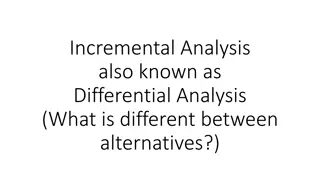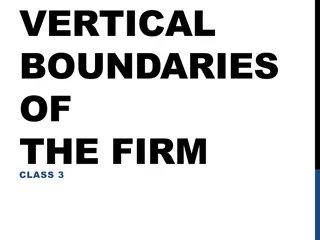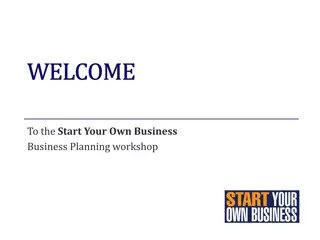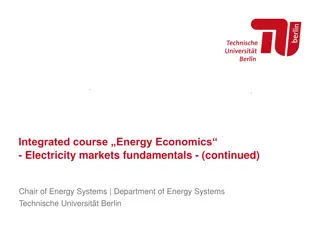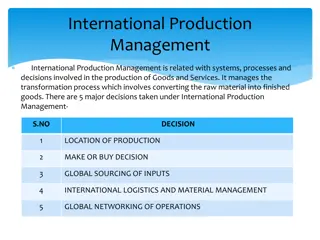Understanding Make or Buy Decisions in Business
Providing a product or service involves various steps in the value chain, such as development, production, and after-sales service. Companies must make strategic make or buy decisions to determine whether to internally carry out certain activities or outsource them to suppliers. Vertical integration offers advantages like better control over quality, while external suppliers can provide economies of scale. Quantifying the financial impact of make or buy decisions involves calculating costs and benefits associated with each option.
Download Presentation

Please find below an Image/Link to download the presentation.
The content on the website is provided AS IS for your information and personal use only. It may not be sold, licensed, or shared on other websites without obtaining consent from the author. Download presentation by click this link. If you encounter any issues during the download, it is possible that the publisher has removed the file from their server.
E N D
Presentation Transcript
Make or Buy Decision Make or Buy Decision Providing a product or service to a customer involves many steps. For example, consider all of the steps that are necessary to develop and sell a product such as a Fitbit fitness watch. First, engineers need to develop the underlying electronics that provide customers with capabilities such as real-time GPS tracking, heart rate monitoring, and activity monitoring. In addition, they need to design a wrist watch that not only houses the electronic circuitry, but that also meets the customers needs in terms of aesthetics, durability, and functionality. Second, the watches need to be assembled, tested, individually packaged, and then boxed in larger quantities to enable shipping. Third, the finished goods need to be transported to retail sales locations and eventually sold to customers. Finally, the company needs to provide after-sale service such as Internet and phone-based help lines, warranty claims, and product returns. All of these activities, from development, to production, to after-sales service are called a value chain.
Separate companies may carry out each of the activities in the value chain or a single company may carry out several. When a company is involved in more than one activity in the entire value chain, it is vertically integrated. Some companies control all the activities in the value chain from producing basic raw materials right up to the final distribution of finished goods and provision of after- sales service. Other companies are content to integrate on a smaller scale by purchasing many of the parts and materials that go into their finished products. A decision to carry out one of the activities in the value chain internally, rather than to buy externally from a supplier, is called a make or buy decision. Quite often these decisions involve whether to buy a particular part or to make it internally. Make or buy decisions also involve decisions concerning whether to outsource development tasks, after-sales service, or other activities.
Strategic Aspects of the Make or Buy Decision Vertical integration provides certain advantages. An integrated company is less dependent on its suppliers and may be able to ensure a smoother flow of parts and materials for production than a nonintegrated company. For example, a strike against a major parts supplier can interrupt the operations of a nonintegrated company for many months, whereas an integrated company that is producing its own parts would be able to continue operations. Also, some companies feel that they can control quality better by producing their own parts and materials, rather than by relying on the quality control standards of outside suppliers. In addition, an integrated company realizes profits from the parts and materials that it is making rather than buying, as well as profits from its regular operations. The advantages of vertical integration are counterbalanced by the advantages of using external suppliers. By pooling demand from many companies, a supplier may be able to enjoy economies of scale.
Use the following three steps to quantify the financial impact of make or buy decisions: Step 1: Calculate the total amount that would be paid to the supplier if the buy option is chosen. Step 2: Calculate the total differential manufacturing costs. These are the variable manufacturing costs and traceable fixed manufacturing costs that will be incurred if the company chooses to make, but avoided if the company chooses to buy.
Troy Engines, Ltd., manufactures a variety of engines for use in heavy equipment. The company has always produced all of the necessary parts for its engines, including all of the carburetors. An outside supplier has offered to sell one type of carburetor to Troy Engines, Ltd., for a cost of $35 per unit. To evaluate this offer, Troy Engines, Ltd., has gathered the following information relating to its own cost of producing the carburetor internally: 1. Assuming that the company has no alternative use for the facilities that are now being used to produce the carburetors, should the outside supplier s offer be accepted?
Troy Engines, Ltd., manufactures a variety of engines for use in heavy equipment. The company has always produced all of the necessary parts for its engines, including all of the carburetors. An outside supplier has offered to sell one type of carburetor to Troy Engines, Ltd., for a cost of $35 per unit. To evaluate this offer, Troy Engines, Ltd., has gathered the following information relating to its own cost of producing the carburetor internally: 2. Suppose that if the carburetors were purchased, Troy Engines, Ltd., could use the freed capacity to launch a new product. The segment margin of the new product would be $150,000 per year. Should Troy Engines, Ltd., accept the offer to buy the carburetors for $35 per unit? Show all computations.
Special Orders Special Orders Managers must often evaluate whether a special order should be accepted, and if the order is accepted, the price that should be charged. A special order is a one-time order that is not considered part of the company s normal ongoing business. Step 1: Calculate the total revenue generated by the special order. Step 2: Calculate the total incremental costs that will be incurred to produce the special order.
Imperial Jewelers is considering a special order for 20 handcrafted gold bracelets to be given as gifts to members of a wedding party. The normal selling price of a gold bracelet is $189.95 and its unit product cost is $149.00 as shown below: Most of the manufacturing overhead is fixed and unaffected by variations in how much jewelry is produced in any given period. However, $4.00 of the overhead is variable with respect to the number of bracelets produced. The customer who is interested in the special bracelet order would like special filigree applied to the bracelets. This filigree would require additional materials costing $2.00 per bracelet and would also require acquisition of a special tool costing $250 that would have no other use once the special order is completed. This order would have no effect on the company s regular sales and the order could be fulfilled using the company s existing capacity without affecting any other order. The customer is willing to pay $169.95 per bracelet.
UTILIZATION OF A CONSTRAINED RESOURCE Managers routinely face the problem of deciding how constrained or limited resources are going to be used. A department store, for example, has a limited amount of floor space and therefore cannot stock every product that may be available. A manufacturer has a limited number of machine-hours and a limited number of direct labor-hours at its disposal. When a limited resource of some type restricts the company's ability to satisfy demand, the company has a constraint. Because the company cannot fully satisfy demand, managers must decide which products or services should be cut back. In other words, managers must decide which products or services make the best use of the constrained resource. Fixed costs are usually unaffected by such choices, so the course of action that will maximize the company's total contribution margin should ordinarily be selected.
Contribution Margin per Unit of the Constrained Resource If some products must be cut back because of a constraint, the key to maximizing the total contribution margin may seem obvious favor the products with the highest unit contribution margins. Unfortunately, that is not quite correct. Rather, the correct solution is to favor the products that provide the highest contribution margin per unit of the constrained resource. But now let us add one more piece of information the plant that makes the panniers is operating at capacity. If the plant as a whole cannot produce any more units, some machine or process must be operating at capacity. The machine or process that is limiting overall output is called the bottleneck it is the constraint. At Mountain Goat Cycles, the bottleneck (i.e., constraint) is a stitching machine. The mountain pannier requires two minutes of stitching time per unit, and the touring pannier requires one minute of stitching time per unit. The stitching machine is available for 12,000 minutes per month, and the company can sell up to 4,000 mountain panniers and 7,000 touring panniers per month. Producing up to this demand for both products would require 15,000 minutes, as shown below: To illustrate, Mountain Goat Cycles makes saddlebags for bicycles called panniers. These panniers come in two models a touring model and a mountain model. Cost and revenue data for the two models of panniers follow: The mountain pannier appears to be much more profitable than the touring pannier. It has a $15 per unit contribution margin as compared to only $12 per unit for the touring model.
Contribution Margin per Unit of the Constrained Resource makes the panniers is operating at capacity. But now let us add one more piece of information the plant that the existing demand for mountain panniers and touring panniers, some orders for the products will have to be turned down. Which? The stitching machine does not have enough capacity to satisfy machine or process must be operating at capacity. The machine or process that is limiting overall output is called the bottleneck it is the constraint. If the plant as a whole cannot produce any more units, some margin per unit of the constrained resource. This figure is computed by dividing a product's contribution margin per unit by the amount of the constrained resource required to make a unit of that product. These calculations are carried out below for the mountain and touring panniers: To answer this question, they will focus on the contribution stitching machine. The mountain pannier requires two minutes of stitching time per unit, and the touring pannier requires one minute of stitching time per unit. The stitching machine is available for 12,000 minutes per month, and the company can sell up to 4,000 mountain panniers and 7,000 touring panniers per month. Producing up to this demand for both products would require 15,000 minutes, as shown below: At Mountain Goat Cycles, the bottleneck (i.e., constraint) is a should be deemphasized. Each minute on the stitching machine that is devoted to the touring pannier results in an increase of $12.00 in contribution margin and profits. The comparable figure for the mountain pannier is only $7.50 per minute. It is now easy to decide which product is less profitable and 12,000 minutes are available Producing up to demand would require 15,000 minutes, but only This is a short-term solution if there is a long-term problem.
Use the following four steps to help determine the most profitable use of a constrained resource: Step 1: Calculate each product's contribution margin per unit. Step 2: Identify the constraining resource and the quantity of that resource that is consumed to make one unit of each product. Step 3: Calculate each product's contribution margin per unit of the constraining resource. Step 4: Rank the products from the highest contribution margin per unit of the constraining resource to the lowest.
Outdoor Luggage Inc. makes high-end hard-sided luggage for sports equipment. Data concerning three of the company s most popular models appear below. Case 1 The total time available on the plastic injection molding machine is the constraint in the production process. Which product would be the most profitable use of this constraint? Which product would be the least profitable use of this constraint? Case 2 A severe shortage of plastic pellets has required the company to cut back its production so much that the plastic injection molding machine is no longer the bottleneck. Instead, the constraint is the total available pounds of plastic pellets. Which product would be the most profitable use of this constraint? Which product would be the least profitable use of this constraint?
Joint Product Costs and the Contribution Approach In some industries, a number of end products are produced from a single raw material input. Maria Wool Cooperative of New Mexico buys raw wool from local sheepherders, separates the wool into three grades coarse, fine, and superfine and then dyes the wool using traditional methods that rely on pigments from local materials. Two or more products that are produced from a common input are known as joint products. The split-off point is the point in the manufacturing process at which the joint products can be recognized as separate products. This does not occur at Santa Maria Wool Cooperative until the raw wool has gone through the separating process. The term joint cost is used to describe the costs incurred up to the split-off point. The undyed wool is called an intermediate product because it is not finished at this point. Nevertheless, a market does exist for undyed wool although at a significantly lower price than finished, dyed wool.
At Santa Maria Wool Cooperative, the joint costs are the $200,000 cost of the raw wool and the $40,000 cost of separating the wool. Joint costs are common costs that are incurred to simultaneously produce a variety of end products. These joint costs are often allocated among the different products at the split-off point. A typical approach is to allocate the joint costs according to the relative sales value of the end products. Although allocation of joint product costs is needed for some purposes, such as balance sheet inventory valuation, allocations of this kind are extremely misleading for decision making.
Sell or Process Further Decisions Joint costs are irrelevant in decisions regarding what to do with a product from the split-off point forward. Once the split-off point is reached, the joint costs have already been incurred and nothing can be done to avoid them. None of the joint costs are economically attributable to any one of the intermediate or end products. The joit costs are a common cost of all of the intermediate and end products and should not be allocated to them for purposes of making decisions about the individual products. Decisions of this type are known as sell or process further decisions. It is profitable to continue processing a joint product after the split- off point so long as the incremental revenue from such processing exceeds the incremental processing cost incurred after the split-off point.
For each end product, use the following three steps to make sell or process further decisions: Step 1: Calculate the sales value if processed further minus the sales value at the split-off point. Step 2: Determine the cost of further processing beyond the split-off point. Step 3: Take the amount in step 1 and subtract from it the amount in step 2. If the result is a positive number, then choose to process further. If it is a negative number, then choose to sell at the split-off point.
Each of these products can be sold as is without further processing. It may be that the company would be better off selling one or more of the products prior to dyeing to avoid the dyeing costs. The appropriate way to make this choice is to compare the incremental revenues to the incremental costs from further processing as follows: As this analysis shows, the company would be better off selling the undyed coarse wool as is rather than processing it further. The other two products should be processed further and dyed before selling them. Note that the joint costs of the wool ($200,000) and of the wool separation process ($40,000) play no role in the decision to sell or further process the intermediate products. These joint costs are relevant in a decision of whether to buy wool and to run the wool separation process, but they are not relevant in decisions about what to do with the intermediate products.
As this analysis shows, the company would be better off selling the undyed coarse wool as is rather than processing it further. The other two products should be processed further and dyed before selling them. Total Project Profit Note that the joint costs of the wool ($200,000) and of the wool separation process ($40,000) play no role in the decision to sell or further process the intermediate products. Coarse Wool Fine Wool Superfine Wool Revenue Revenue Revenue 120,000 240,000 90,000 450,000 Further Processing Costs Coarse Wool Fine Wool Superfine Wool (60,000) (10,000) These joint costs are relevant in a decision of whether to buy wool and to run the wool separation process, but they are not relevant in decisions about what to do with the intermediate products. Joint Costs Wool purchase Separation (200,000) (40,000) Total Profit 140,000
Dorsey Company manufactures three products from a common input in a joint processing operation. Joint processing costs up to the split-off point total $350,000 per quarter. The company allocates these costs to the joint products on the basis of their relative sales value at the split-off point. Unit selling prices and total output at the split-off point are as follows: Each product can be processed further after the split-off point. Additional processing requires no special facilities. The additional processing costs (per quarter) and unit selling prices after further processing are given below: Which product or products should be sold at the split-off point and which product or products should be processed further?
Cane Company manufactures two products called Alpha and Beta that sell for $120 and $80, respectively. Each product uses only one type of raw material that costs $6 per pound. The company has the capacity to annually produce 100,000 units of each product. The company considers its traceable fixed manufacturing overhead to be avoidable, whereas its common fixed expenses are deemed unavoidable and have been allocated to products based on sales dollars. Its unit costs for each product at this level of activity are given below: (Answer each question independently unless instructed otherwise.)
Cane Company manufactures two products called Alpha and Beta that sell for $120 and $80, respectively. Each product uses only one type of raw material that costs $6 per pound. The company has the capacity to annually produce 100,000 units of each product. The company considers its traceable fixed manufacturing overhead to be avoidable, whereas its common fixed expenses are deemed unavoidable and have been allocated to products based on sales dollars. Its unit costs for each product at this level of activity are given below: 1. What is the total amount of traceable fixed manufacturing overhead for the Alpha product line and for the Beta product line? (Answer each question independently unless instructed otherwise.)
Cane Company manufactures two products called Alpha and Beta that sell for $120 and $80, respectively. Each product uses only one type of raw material that costs $6 per pound. The company has the capacity to annually produce 100,000 units of each product. The company considers its traceable fixed manufacturing overhead to be avoidable, whereas its common fixed expenses are deemed unavoidable and have been allocated to products based on sales dollars. Its unit costs for each product at this level of activity are given below: 2. What is the company s total amount of common fixed expenses? (Answer each question independently unless instructed otherwise.)
Cane Company manufactures two products called Alpha and Beta that sell for $120 and $80, respectively. Each product uses only one type of raw material that costs $6 per pound. The company has the capacity to annually produce 100,000 units of each product. The company considers its traceable fixed manufacturing overhead to be avoidable, whereas its common fixed expenses are deemed unavoidable and have been allocated to products based on sales dollars. Its unit costs for each product at this level of activity are given below: 3. Assume that Cane expects to produce and sell 80,000 Alphas during the current year. One of Cane s sales representatives has found a new customer that is willing to buy 10,000 additional Alphas for a price of $80 per unit. If Cane accepts the customer s offer, how much will its profits increase or decrease? (Answer each question independently unless instructed otherwise.)
Cane Company manufactures two products called Alpha and Beta that sell for $120 and $80, respectively. Each product uses only one type of raw material that costs $6 per pound. The company has the capacity to annually produce 100,000 units of each product. The company considers its traceable fixed manufacturing overhead to be avoidable, whereas its common fixed expenses are deemed unavoidable and have been allocated to products based on sales dollars. Its unit costs for each product at this level of activity are given below: 4. Assume that Cane expects to produce and sell 90,000 Betas during the current year. One of Cane s sales representatives has found a new customer that is willing to buy 5,000 additional Betas for a price of $39 per unit. If Cane accepts the customer s offer, how much will its profits increase or decrease? (Answer each question independently unless instructed otherwise.)
Cane Company manufactures two products called Alpha and Beta that sell for $120 and $80, respectively. Each product uses only one type of raw material that costs $6 per pound. The company has the capacity to annually produce 100,000 units of each product. The company considers its traceable fixed manufacturing overhead to be avoidable, whereas its common fixed expenses are deemed unavoidable and have been allocated to products based on sales dollars. Its unit costs for each product at this level of activity are given below: 6. Assume that Cane normally produces and sells 90,000 Betas per year. If Cane discontinues the Beta product line, how much will profits increase or decrease? (Answer each question independently unless instructed otherwise.)
Cane Company manufactures two products called Alpha and Beta that sell for $120 and $80, respectively. Each product uses only one type of raw material that costs $6 per pound. The company has the capacity to annually produce 100,000 units of each product. The company considers its traceable fixed manufacturing overhead to be avoidable, whereas its common fixed expenses are deemed unavoidable and have been allocated to products based on sales dollars. Its unit costs for each product at this level of activity are given below: 7. Assume that Cane normally produces and sells 40,000 Betas per year. If Cane discontinues the Beta product line, how much will profits increase or decrease? (Answer each question independently unless instructed otherwise.)
Cane Company manufactures two products called Alpha and Beta that sell for $120 and $80, respectively. Each product uses only one type of raw material that costs $6 per pound. The company has the capacity to annually produce 100,000 units of each product. The company considers its traceable fixed manufacturing overhead to be avoidable, whereas its common fixed expenses are deemed unavoidable and have been allocated to products based on sales dollars. Its unit costs for each product at this level of activity are given below: 9. Assume that Cane expects to produce and sell 80,000 Alphas during the current year. A supplier has offered to manufacture and deliver 80,000 Alphas to Cane for a price of $80 per unit. If Cane buys 80,000 units from the supplier instead of making those units, how much will profits increase or decrease? (Answer each question independently unless instructed otherwise.)
Cane Company manufactures two products called Alpha and Beta that sell for $120 and $80, respectively. Each product uses only one type of raw material that costs $6 per pound. The company has the capacity to annually produce 100,000 units of each product. The company considers its traceable fixed manufacturing overhead to be avoidable, whereas its common fixed expenses are deemed unavoidable and have been allocated to products based on sales dollars. Its unit costs for each product at this level of activity are given below: 11. How many pounds of raw material are needed to make one unit of Alpha and one unit of Beta? (Answer each question independently unless instructed otherwise.)
Cane Company manufactures two products called Alpha and Beta that sell for $120 and $80, respectively. Each product uses only one type of raw material that costs $6 per pound. The company has the capacity to annually produce 100,000 units of each product. The company considers its traceable fixed manufacturing overhead to be avoidable, whereas its common fixed expenses are deemed unavoidable and have been allocated to products based on sales dollars. Its unit costs for each product at this level of activity are given below: 12. What contribution margin per pound of raw material is earned by Alpha and Beta? (Answer each question independently unless instructed otherwise.)
Cane Company manufactures two products called Alpha and Beta that sell for $120 and $80, respectively. Each product uses only one type of raw material that costs $6 per pound. The company has the capacity to annually produce 100,000 units of each product. The company considers its traceable fixed manufacturing overhead to be avoidable, whereas its common fixed expenses are deemed unavoidable and have been allocated to products based on sales dollars. Its unit costs for each product at this level of activity are given below: 13. Assume that Cane s customers would buy a maximum of 80,000 units of Alpha and 60,000 units of Beta. Also assume that the company s raw material available for production is limited to 160,000 pounds. How many units of each product should Cane produce to maximize its profits? (Answer each question independently unless instructed otherwise.)


